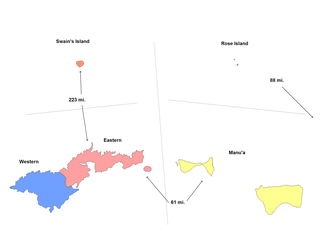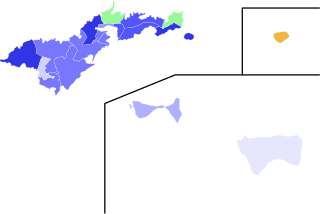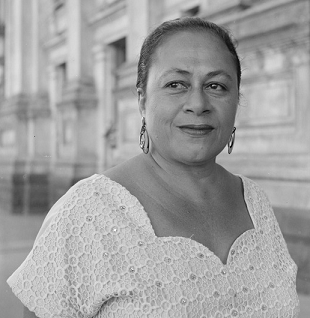 |
|---|
The president of the American Samoa Senate is the presiding officer of that legislature.
 |
|---|
The president of the American Samoa Senate is the presiding officer of that legislature.
| Name | Term |
|---|---|
| Rapi Sotoa | 1958–1968 |
| Salanoa S. P. Aumoeualogo | 1969–1970 |
| Leaeno Reed | 1971–1972 |
| Salanoa S. P. Aumoeualogo | 1973–1978 |
| Galea'i P. Poumele | 1979–1985 |
| Letuli Toloa | 1985–1996 |
| Lutu T. S. Fuimaono | 1996–2004 |
| Lolo Matalasi Moliga | 2005–2008 |
| Lutu M. Moli | 2008–2009 |
| Gaoteote Palaie Tofau | 2009–2021 |
| Tuaolo Manaia Fruean [1] | 2021–present |

Pago Pago is the capital of American Samoa. It is in Maoputasi County on Tutuila, the main island of American Samoa.

The American Samoa Fono is the territorial legislature of American Samoa. Like most states and territorial legislatures of the United States, it is a bicameral legislature with a House of Representatives and a Senate. The legislature is located in Fagatogo along Pago Pago harbor.

The American Samoa House of Representatives is the lower house of the American Samoa Fono. The House consists of 21 members serving two-year terms, with 20 popularly elected representatives, and one delegate from Swains Island elected in a public meeting.

The American Samoa Senate is the upper house of the American Samoa Fono. The Senate, like the lower House of Representatives, is a nonpartisan body. It is composed of 18 senators, serving a four-year term.

Fagatogo is the downtown area of Pago Pago. Located in the low grounds at the foot of Matafao Peak, it was the location of the first American settlement on Tutuila Island. It includes the sub-village of Malaloa. Today, Fagatogo is the government, commercial, financial, and shipping center of Tutuila. It is also the administrative capital of American Samoa. It is the location of the American Samoa Fono (legislature), and is listed in the Constitution of American Samoa as the territory's official seat of government. Its population is 1,737.

The Eastern District is one of the primary districts of American Samoa. It consists of the eastern portion of Tutuila, American Samoa's largest island, plus the island of Aunu'u. The district has a land area of 67.027 km2 (25.879 sq mi) and a 2010 census population of 23,030. It contains 34 villages plus a portion of Nuʻuuli village. Among these are Pago Pago, Fagatogo, and Utulei.

The following outline is provided as an overview of and topical guide to American Samoa:

American Samoa is an unincorporated territory of the United States located in the Polynesia region of the South Pacific Ocean. Centered on 14.3°S 170.7°W, it is 40 miles (64 km) southeast of the island country of Samoa, east of the International Date Line and the Wallis and Futuna Islands, west of the Cook Islands, north of Tonga, and some 310 miles (500 km) south of Tokelau. American Samoa is the southernmost territory of the United States, situated 2,200 miles (3,500 km) southwest of the U.S. state of Hawaii, and one of two U.S. territories south of the Equator, along with the uninhabited Jarvis Island.

Vernon Huber was a United States Navy rear admiral, and the governor of American Samoa from April 22, 1947, to June 15, 1949. He was born in Philadelphia, Illinois, and was appointed to the United States Naval Academy from that state. He served as the first commanding officer of the destroyer USS Livermore upon its launch in 1940. After his appointment, he advocated the diversification of the American Samoan economy. He also helped to increase the level American Samoan self-government, and was the first governor to serve alongside a Samoan legislature, the American Samoa Fono.

The Speaker of the American Samoa House of Representatives is the presiding officer of that legislature.

The Courthouse of American Samoa, formerly Administration Building, Navy No. 21, is a historic building near Pago Pago Harbor in Fagatogo, American Samoa. It is a two-story wood-frame building mounted on concrete piers, with a two-story veranda on three sides. A concrete vault is located at the back of the building. The court house was reported by the local commander to have been completed about 1904. It housed the offices and other facilities from which the United States Navy administered the island from its construction until 1952, and was where advisory councils of the island's indigenous leaders were held. The building is one of the oldest standing in American Samoa, having survived typhoons and other perils.

Maʻopūtasi County is located in the Eastern District of Tutuila Island in American Samoa. Maʻopūtasi County comprises the capital of Pago Pago and its harbor, as well as surrounding villages. It was home to 11,695 residents as of 2000. Maʻopūtasi County is 6.69 square miles (17.3 km2) The county has a 7.42-mile (11.94 km) shoreline which includes Pago Pago Bay.
Aumoeualogo Te’o J. Fuavai was a former American Samoa politician who represented the Republican Party of American Samoa and served as a member of the American Samoa House of Representatives, as a territorial Senator, and Speaker of the House of Representatives. He has also been the Commissioner of Public Safety, Director of Public Works, President of the American Samoa Rugby Union (1976-2019), Chairman of the Catholic Diocesan Council, and Chairman of the Republican Party of American Samoa.
Malaloa is a sub-village of Fagatogo and is located at the end of Pago Pago Harbor in American Samoa. It is located in-between Fagatogo proper and the village of Pago Pago. Cruising boats entering and leaving Pago Pago should clear at Malaloa Marina. The Malaloa Marina was opened for cruisers’ use and has added a customs wharf to handle inbound and outbound clearances.
Fainu'ulelei S. Utu was an American Samoan politician. He served as Speaker of the House of Representatives (1969–1970) and a member of the Fono legislature as both a member in the House of Representatives (1969–1973) and the Senate (1973–1974).

General elections were held in American Samoa on 3 November 2020. Voters elected a governor and lieutenant governor, members of the House of Representatives and the American Samoan delegate to the United States Congress. Incumbent Governor of American Samoa Lolo Matalasi Moliga was not eligible for reelection due to term limits. In American Samoa, gubernatorial candidates run on a non-partisan basis and as a slate together with their lieutenant governor candidate.

Mabel Coleman Reid, also known by the Samoan name Sinaitaaga, was an American Samoan politician. In 1953 she was one of the first two women elected to the Fono, when she and Zilpher Jennings won seats in the House of Representatives.
Luaitaua Gene Pan is a nonpartisan politician and member of the American Samoa House of Representatives for district 5. He was elected to the House on November 8, 2022, and took office January 3, 2023.